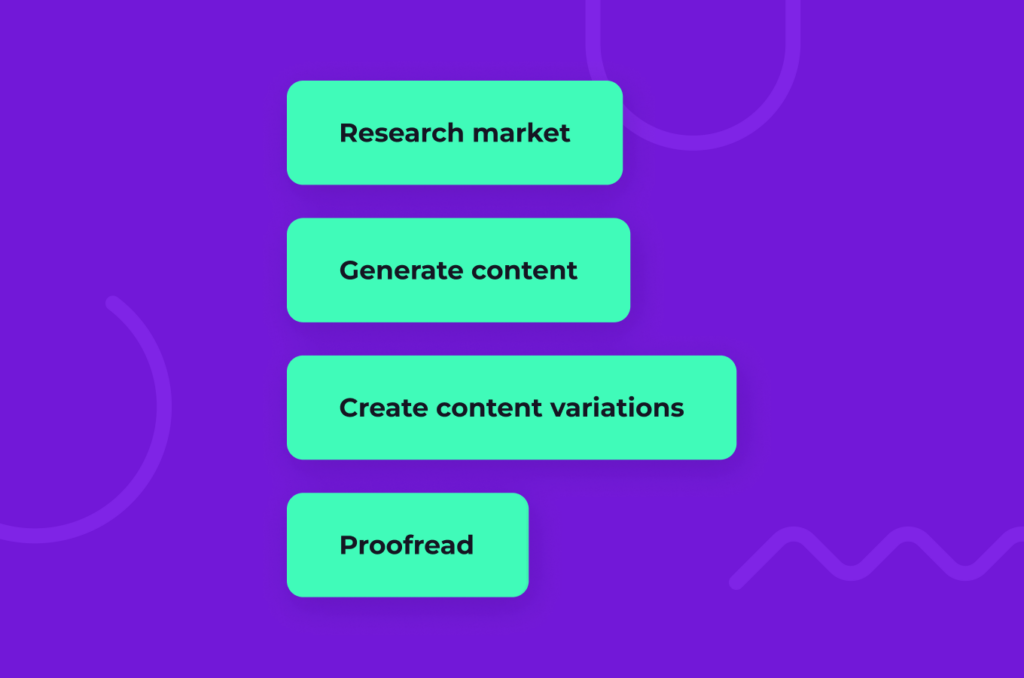Weirdly, this article hasn’t been written by AI. Nor it is AI-assisted. I don’t want to ask AI what it thinks about AI. Humans are still in charge of marketing, and we need to know how to approach this AI thing with clear heads and open minds.
I want to take away hype and techno-prophecies which never come true but acknowledge the possibilities that generative AI brings and discuss the potential of AI for native advertisers.
So buckle up, this won’t be like one of those single-sided smooth rides, there will be some harsh words describing even harsher reality but worry not, I will talk about an actual way AI can smoothen your native advertising experience.
Why AI in native?
Native advertising proposes ads that blend with the surrounding context. So, you have article-like ads that look informational but try to sell you something. “Think like a publisher” is a native advertiser’s mantra. The idea behind it is if you fit perfectly into the context, no one will know that your offer is an ad and therefore, people will grant you the same trust that they have for the website they are visiting.
If native ads and native landing pages are supposed to be more like news articles, they should have a lot of content. This is where most bloggers and tech enthusiasts are eager to tell you that you can generate plenty of content with ChatGPT.
But… have you tried using ChatGPT for content creation. Like, for real?
It has an imagination of a high-school student doing an essay on a topic they don’t like, and a vocabulary stolen from middle management’s handbook.
“In the ever-evolving world of digital marketing…”
“The following paragraph describes the importance of AI in native advertising…”
“In conclusion, content matters a lot in native advertising…”.

It’s unreadable, and frankly, cruel to end readers.
That is, if you are using AI wrong.
Let’s get straight to the point: AI is not a replacement for a talented marketer, content writer or marketing executive. It is a tool that, like all tools, has to be used correctly to bring meaningful results.
Writing full articles or advertorials with AI after submitting a simple prompt like “Write an article about how awesome our service or product is” is like banging a hammer on a pile of wood and nails hoping that it will change into a shed.
This conclusion is not a feeling or intuition, it is a consensus of talented marketers that actually run native campaigns and were first to assess the potential of AI in native advertising.
The case of search engines
We are an ad tech company that partners with plenty of smart people and companies from native ads space. They still write stuff or hire human content marketers.
But they don’t tell them not to use AI, oh no.
Consider this: nowadays, search engines are able to fetch almost any information we want. Google especially is not only a service that looks for links of relevant web pages: if you ask it about the cost of a dollar in euro – it will immediately get it, if you are interested how your country’s volleyball team is doing during championships – you won’t have to go to any specific websites.
Google’s job is to get information for you.
Yet journalists still exist, people still read newspapers or their digital incarnations. The reading patterns may have changed but people still like to get information selected, analyzed & written by humans instead of typing “Will there be WW3” into a search engine every morning.
What is AI for in native advertising?
AI in native advertising is about increasing efficiency, not replacing a marketer’s full-time job. It’s about helping them and allowing them to focus on a strategic level.
There are plenty of tools that marketers already use: SEO platforms, content checkers, trend analysis tools and so on. AI is just another addition to a marketer’s toolbox. And not for generating content.
In my opinion, the most overlooked and yet the most revolutionary aspect of generative AI is not that it can generate text out of thin air (which is impressive but not that useful after all) but that it can rework existing text toward different angle or tone of voice (which is frankly ten times more useful).

AI can work on the text prepared by professional writers and create variations of it. AI working in tandem with human marketers can yield more results than generating bland texts from scratch.
Before we dive into the many ways of how one can use AI to improve creating successful native ad campaigns, let’s answer one question:
Which AI anyway?
AI is not one tool; it is a collection of platforms built for various purposes even before ChatGPT dominated headlines.
But in the current context, when people write “AI”, they mean “ChatGPT” in its free or paid versions.
ChatGPT is the most versatile text generator that is aimed to give a conversational experience to users. It can generate any text you want, from product names, through headlines, summaries to whole articles. The free version is based on the Open AI’s GPT 3.5 language model, which is capable as a party trick but slightly less so when you task it with writing a whole piece that tries to deliver its point subtly.
The paid version is based on the GPT 4 model, which offers advanced logic and better writing skills, but it is still a general-purpose conversational AI. It was trained to help native advertisers to the same extent as to create Harry Potter fanfics.
Jasper.AI is a more purpose-built platform with marketers in mind. Although existing in paid version only, Jasper is a solid alternative to ChatGPT for advertisers because of web extensions and templates. It KNOWS that you want to squeeze a marketing content out of it.
There are also AI models brought by search engine providers: Google Bard and Microsoft Bing AI. The former was a bit late for the initial hype surrounding the launch of ChatGPT but it is catching up. The recent update gave Google Bard some much-needed plugins that allow it to access personal data, as well as fact-check the result it produces with Google Search Results.
Microsoft Bing is in its core an AI-powered search engine. It can generate text but is best in compiling search results into a readable answer. It is great when you want to quickly compare two products or get some interesting statistics. Bing includes links to relevant pages in its answers, making it a turbo-charged search engine.
How to use AI to improve you native advertising campaigns
Now, let’s move onto concrete things you can task AI with that should improve or speed up your marketing efforts.

1. Research market
The first thing you can do with AI is to ask it about your audience. Things like common problems people have that your product or service may solve. This will give you an idea about an angle you want to use in your advertising.
This is a moment you have to take into account if AI platform that you are using is connected to the Internet. ChatGPT famously is not – its knowledge about the world stops at September 2021. If your product is not new – for example, a standard nicotine patch – you can still ask ChatGPT about problems that people have when trying to quit smoking.
However, if you advertise something new, like a new iPhone model, ChatGPT will not help you. Admittedly, you can use web browser extensions to give it a janky Internet access (such extensions simply do a quick Google search on relevant topic and inject the most popular results into your prompt) but it’s a far cry from fully connected artificial intelligence.
You can turn to search engine AIs from the likes of Microsoft or Google to get more up-to-date results.
You can also use those AIs to gather important information that will help you prepare your content: statistics, product comparisons, state of the industry reports and so on.
2. Generate content
Now, if you want to use AI for content generation – you can! I’ve been going on how AI generates empty and bland content when compared to professional writers but sometimes that’s all you need.
You don’t have to write every time like you’re writing ‘the next great American novel’, sometimes you just need a piece of text that conveys a simple message. Sometimes you need to write ‘About us’ section, for example.
If you are keen on using AI to write content for the whole advertorial page, there are some approaches you can take.
You can task AI with writing a brief that you will then turn into a full article or generate each section paragraph of a page separately and then stitch them together in the best way you can. This yields far better results than just asking it about authoring the entire article from scratch.
While we are on the topic of generating content, it is important to know that the final results rely vastly on the types of prompts (commands) you use. The more instructions you provide, the better AI will handle your request. So, here’s a quick handout of some rules you should follow when creating prompts.

- Define a role. Tell AI that it should act as a content writer, marketer, or actual product user. This will set the tone and vocabulary of the response.
- Provide parameters. Instruct AI about how many words it can use, what kind of language it should use (even choosing between American or British English matters), if it should use bullet points or lists and so on.
- Define tone of voice. You can provide detailed instructions on if the text should be informative, funny, formal or even rhymed. This should be in line with your audience research and overall intuition.
- Outline audience. You can tell AI who the target reader is: people trying to quit smoking, tech enthusiasts, single parents, and so on.
- Provide examples. This is the often-overlooked part but you can provide examples of your previous texts so AI can try to mimic your writing style. You can also feed it with what your competitors wrote, if you want your content to be similar.
Did you know that there are AIs specialized in generating prompts for other AIs? Reality will always be weirder than fiction, because fiction has to be probable, and reality doesn’t have such limitations.
3. Create content variations
This is the biggest point of using AI in native advertising. See, native, by its nature, is a content-heavy format. Advertisers need to produce whole articles that are not just vanity fluff pieces about an item they want to sell. Advertisers should really care that people read their content – some of them even put the CTA button at the end of the advertorial article just to make sure that the person had read it.
Such long content helps to sift away uninterested parties, leaving only engaged or convinced prospective buyers going to the offer page.
To truly excel in native, you need to work on your content until you can’t improve it anymore. And by improving I don’t mean to write it in a better style but to make the whole campaign more profitable.
Native advertisers test variations of landing pages with slightly different content all the time. They put those page variations in front of the same audience and let the numbers decide which one is better.
So instead of generating content, what you should do is to write content by yourself and use AI to create page variations toward different styles, audiences or tones of voice using your content as a baseline.
Test such content variations using ad tracking software such as Voluum to optimize your ad strategy to the point where it cannot be optimized anymore, and each new attempt brings worse results.
Put your content into ChatGPT or other services and instruct it to rewrite it but in a less formal way or change the language toward teenagers.
Test many variations. Big agencies test hundreds of landing page variations for their customers – but they have teams of content writers for that. You have AI. If you use it smartly, you and it can be the whole agency.
4. Proofread
The last thing you can do with AI language models is to check your content for any error. I know that you have Grammarly or Microsoft Editor, but AI can spot more general errors encompassing whole sentences, not just typos.
Polish your content with AI, fine tune headlines, CTAs and titles. It takes seconds but the improvements may be impressive.
AI will tell you a lot… but not how your campaigns are doing
AI cannot monitor your marketing campaigns in real-time… yet. For this, you can reach for yet another platform from the toolbox – the briefly mentioned ad tracker.
There are many ad analytics and tracking platforms out there, but Voluum is one of the best for native marketers, since it was designed with massive scale tests in mind.
It allows you to manage hundreds of campaigns and create auto-rules that use the ‘if-then’ logic, so you won’t be swallowed by micromanaging every aspect of running campaigns.
This is the part when we sum everything up
[In the realm of native advertising, the intersection of AI and human ingenuity presents a nuanced landscape. As we traverse this terrain, it becomes abundantly clear that AI is not here to supplant human marketers, but rather to be a powerful tool in their arsenal, akin to the proverbial hammer in the hands of a skilled carpenter.]
This is a conclusion of this article generated by ChatGPT. You can be the judge on the quality of it but for me, it is ‘abundantly clear’ that I won’t be ‘supplanted’ by AI ‘akin to the proverbial’ video that killed the radio star.
So, let’s create a content that beats whatever gibberish AI is spitting out, has more life and more punch to it and get ahead of those marketers who put their fate into AI completely. And also, get ahead of those marketers who don’t use Voluum for A/B testing, automation, and analytics – you will be surprised how easy it is!





